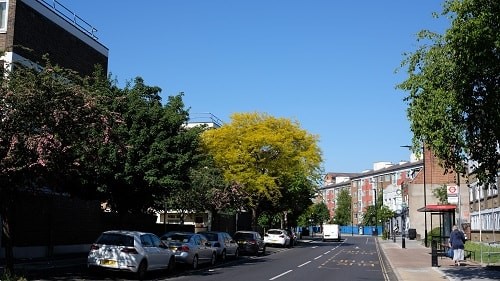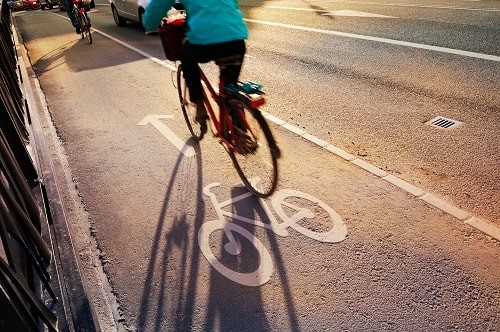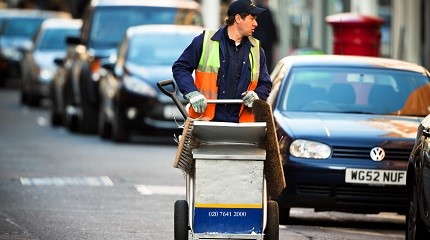On an average day you will take over 23,000 breaths. If you are living in an urban environment, the chances are every one of those breaths will be polluted.
Features
What impact did lockdown have on air pollution?
But we have not been having average days for a while now. Lockdown has dramatically reduced the numbers of cars on the road, so it must have also reduced the air pollution we breathe in – or has it?
I spoke to Dr Gary Fuller, air pollution scientist at King’s College London, to find out what happened to our air quality during those strange weeks since lockdown began on 25 March and up until measures were eased more recently in May. What have we learned and what lessons can we take forward to drive down air pollution for good?
 Gary Fuller: "The Himalayas are visible from places that people have previously never seen them for a generation."
Gary Fuller: "The Himalayas are visible from places that people have previously never seen them for a generation."
Blue skies
The UK has enjoyed some extremely good weather recently, but from a scientific perspective the sky really has become bluer and clearer on many days in lockdown. “As I look outside my window at the moment, the intensity of the blue of the sky is just entirely different to what it is normally,” says Gary.
All over the world too, new vistas have been revealing themselves. “The Himalayas are visible from places that people have previously never seen them for a generation.”
Clearer skies are a sign of some improvement in air quality. Gary explains that the main factor in visibility is particle pollution. “They are tiny; 100 nanometers in size and they’re very, very efficient at scattering light. If you climb up somewhere very high; like the Lake District, or a hill, and in the middle of the day you’ll notice it looks hazy in certain directions. That’s not fog, that’s scatter from particle pollution. That’s disappeared by quite a lot.”
 Homerton, east London during lockdown. Clearer skies are a sign of some improvement in air quality
Homerton, east London during lockdown. Clearer skies are a sign of some improvement in air quality
Traffic – just one source
The air pollution story is not quite as simple as that, however. The UK ground to a halt on 23 March. During peak lockdown, eight in 10 adults (83.5 per cent) said they had either not left their home or only left for the permitted reasons, such as one form of exercise, according to ONS statistics issued on 30 April. The government says that according to its findings, 44 per cent of adults have worked from home during lockdown in April compared to 12 per cent at same point last year.
So, people have not been driving as much, cutting the number of vehicles on the roads by 50 per cent. But although we have seen some lovely clear days, overall, particulate pollution – PM10 and PM2.5, which are the nasty particulates that can reach the heart and lungs owing to their tiny size – has in fact risen during the lockdown.
Gary explains: “We’ve seen the highest concentrations of PM10 and PM2.5 that we’ve measured this year so far, and you’ve got to say, well, why is that? Traffic volumes have reduced a great deal and we’ve seen large reductions in traffic pollutants as a consequence which is really good, but I think if you would talk to the average person in the street, they would think the air pollution is almost synonymous with traffic. What this is showing us is that there are many more pollution sources than just traffic.”
Good weather for air pollution?
According to government air quality statistics in the UK, which cover 1987 to 2019, a third of particulate matter PM10 and PM2.5 is transported to the UK from other European countries.
Pollution emitted from power plants and factories based in Europe has literally been blowing over to our shores and our recent weather patterns have encouraged it on its way. “PM2.5 particles can stay in the air for a week or so,” says Gary. “When the winds come from the east, we can get pollution that’s travelled all the way across continental Europe.”
This is known as anticyclonic weather. “When the wind comes off the Atlantic, we’re first in line for the fresh air. We’ve had three or four periods now where that normal westerly airflow has reversed.”
In TS Eliot’s famous poem, the Wasteland, he wrote that ‘April is the cruellest month’. This is also true for air pollution, the next surprise of our talk with Gary, which is that spring, above winter, autumn and summer, is the peak time for air pollution.
He explains: “At this time of year, farmers start to plant things. They’re starting to fertilize their fields as well, and a lot of animals which have been kept locked up for most of winter are released for the first time and the manure that’s been stored over winter is then spread out onto the fields. And this leads to massive release of ammonia which reacts with the traffic and industrial pollution.”
Analysis of pollution particles taken from south and central London during lockdown has confirmed that agriculture was partly responsible for the pollution episodes during lockdown: “We can measure their chemical properties and we can see the most of the particles have an agricultural fingerprint. It’s a hybrid of agriculture and industry. Within one particle you get ammonia from agriculture and the nitrate from a traffic and industry combined.”
Damage limitation
But we need good news stories when it comes to the Covid-19 crisis. There is still one to be told when it comes to air pollution.
The series of high pollution episodes that Gary is referring to, which happened at the end of March and in early April, measured ‘moderate’ on the Department for Environment, Food and Rural Affairs’ (DEFRA) air quality index, which provides daily rankings on a scale from 1 to 10.
These could have been far worse, he says: “Often these springtime events can give us numbers on the index at nines and 10s, the highest on the scale. The lockdown has helped to avert really quite serious series of springtime air pollution episodes.”
In London, nitrogen dioxide (NOx) emissions have also dropped dramatically. Nitrogen dioxide emissions from diesel traffic cause 23,500 of the 40,000 premature deaths from air pollution each year, according to figures from Defra. “What we’re seeing in nitrogen dioxide in London is about a 20 per cent reduction on average,” says Gary.
Calculations by King’s College’s Environmental Research Team show that at the busiest roads, Marylebone Road and Euston Road, Nox emissions were down 76 per cent and 62 per cent respectively.
Post lockdown – the opportunity
Transport might not be the whole equation when it comes to air pollution but it is a big part of it and this is an opportunity to be seized – many want to move forward, not return to the bad old days of dirty air.
In a poll carried out by YouGov on behalf of Cycling UK, 63 per cent of people said they want to see traffic- free cycle tracks and 36 per cent said they would use their cars less after lockdown.
 The UK government is urging people to use bicycles more to reduce air pollution, announcing a £2bn active travel fund
The UK government is urging people to use bicycles more to reduce air pollution, announcing a £2bn active travel fund
Gary comments: “If you think of all the things we could tackle the one that might have the greatest good when it comes to public health is patterns of transport. If we can take people from a motorised transport into active travel, we have the opportunity not only to tackle air pollution, but we can reduce the emissions that are linked to climate change as well.”
On 9 May, the government announced a £2 billion active travel fund to create pop-up bike lanes in cities and wider pavements. Plans in Greater Manchester include 150 miles of protected cycle track and in London, Transport for London to will create a ‘bike Tube’ network above Underground lines.
Duncan Dollimore, Cycling UK’s head of campaigns said: “This announcement was significant because it commits the government to make public health part of transport policy, and active travel a core element.”
We are also going through a huge upheaval with coronavirus, and this is also affecting normal health and safety and environmental management practices.
Health and safety duties require employers to control the risk arising from a work activity, but coronavirus cannot be limited to the workplace or work activity. Perhaps air pollution, which has historically fallen through the gap in duty of care regulations, will have its time in the sun.
Gary says: “The whole Covid-19 situation has made us much more aware that employers have a responsibility to look after their staff, but there is also less emphasis and thought on just [caring for them] in the workplace, it is [caring] for the workers.”
He continues: “The physical distancing that everyone has to do even if they are outside might bring about greater awareness among workers and among employers that there’s a responsibility to protect employees, no matter where they are. Health and safety doesn’t stop at the factory gates.”
This is also good news for British Safety Council’s campaign Time to Breathe, which is calling on employers to use its Canairy tool (an app built with King’s College London) to reduce outdoor workers’ exposure to air pollution. “This is the time when the Canairy app is really, really useful because it’s warning people to be mindful of their air pollution exposure,” says Gary.
 Coronavirus has shown us that risks to workers are everywhere, including the risk of air pollution to the health of outdoor workers
Coronavirus has shown us that risks to workers are everywhere, including the risk of air pollution to the health of outdoor workers
So, lockdown has shown us harmful smog episodes have been averted thanks to the reduction in traffic. It has also demonstrated we can live differently, with many opportunities to make other changes that could reduce our impact on the environment and its impact on us. “Lockdown has given us a glimpse into what a future might be look like as we begin to decarbonise, [in a world where] there’s fewer industrial emissions, when we electrify our vehicles or move people to active travel. It gives us a glimpse as to what those worlds might look like,” concludes Gary.
Dr Gary Fuller is an air pollution scientist at King’s College London. He is author of:The Invisible Killer: The Rising Global Threat of Air Pollution — and How We Can Fight Back
FEATURES

Sedentary working and how to combat the ‘sitting disease’
By Gavin Bradley, Active Working on 05 April 2024
Prolonged and excessive sitting poses a major risk to our health, but the Get Britain Standing campaign and On Your Feet Britain Day on 25 April are a great way of encouraging workers to sit less and move more.

Company culture and wellbeing: a crucial link
By Bex Moorhouse, Invigorate Spaces on 05 April 2024
Investing in measures to support worker wellbeing will be ineffective unless the company culture genuinely incorporates values like teamwork, involvement, flexibility and innovation.

Office design and culture: happier and healthier staff – or the opposite?
By Guy Osmond, Osmond Ergonomics on 03 April 2024
Applying ergonomic principles to workstation set-ups and ensuring the physical environment supports neurodivergent people are just some of the ways of creating an office where everyone can thrive, but a supportive and positive organisational culture is vital too.


